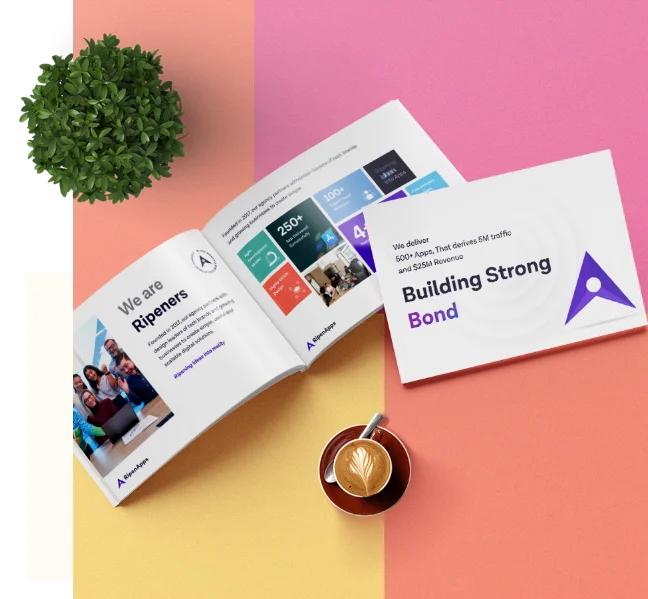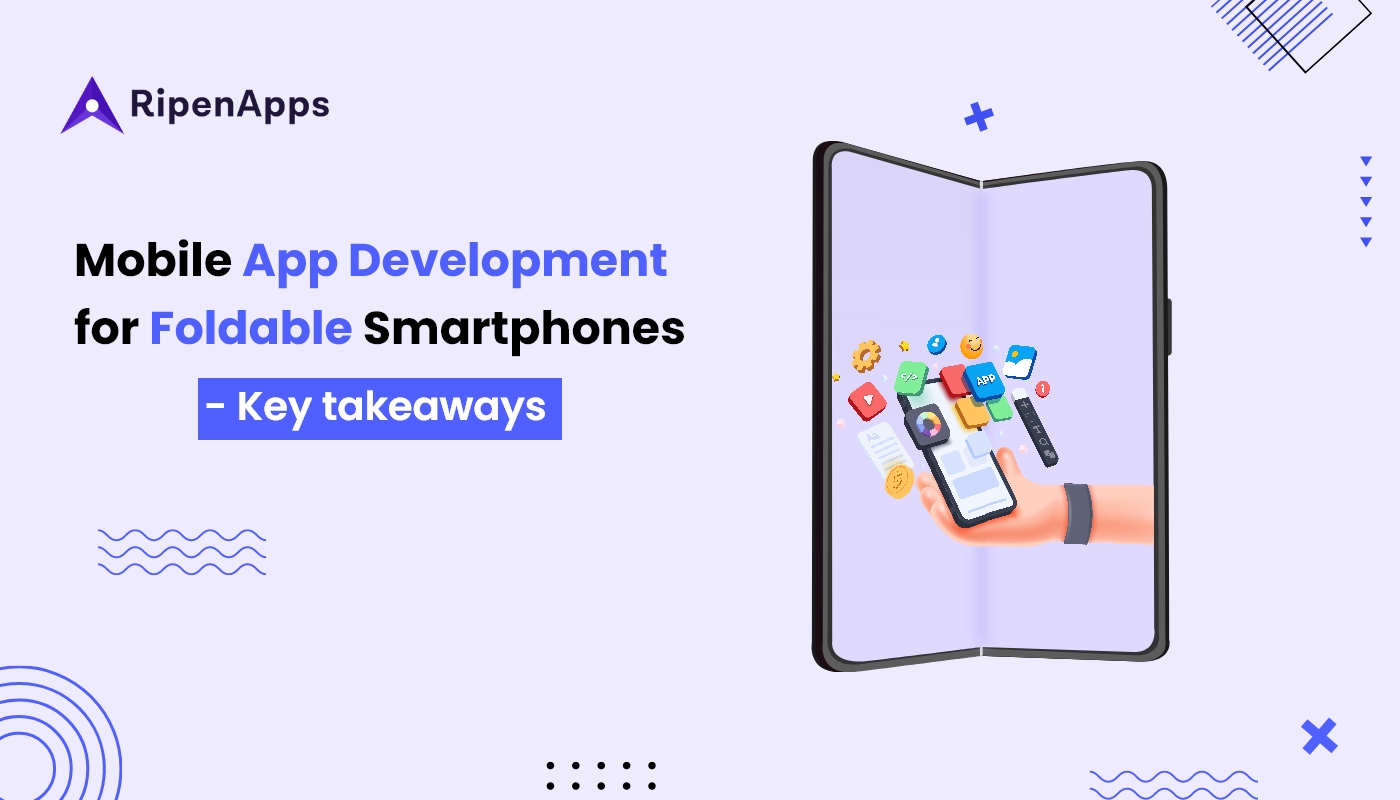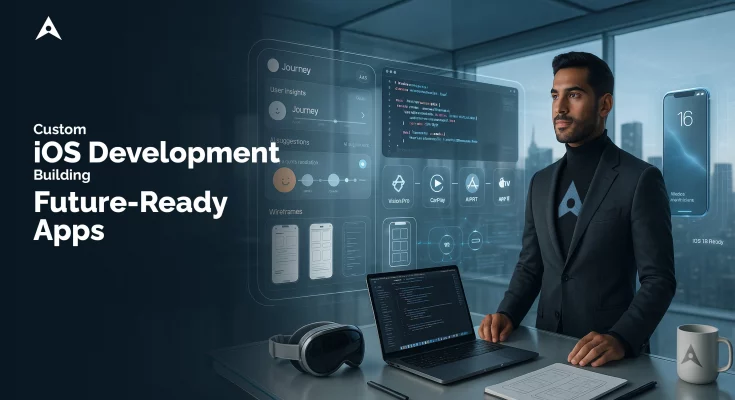Folding phones bring a great opportunity for the mobile app development industry. The smartphone industry is reimagining powerful ways to let people perform their productive work right from their smartphones and tablets. One of the unique creativity of the smartphone industry is Folding phones. With its debut in September 2019, Samsung announced the first foldable smartphone, and since then, it has become hype in the mobile app development market.
Entrepreneurs have started to unfold the technicalities involved in the app development process for folding phones. And this article is all they need to understand the key takeaways while building apps for folding smartphones.
Table of Contents
What is a foldable smartphone technically?
A foldable smartphone is a combination of a tablet and a smartphone. For example, if you look at the Samsung Galaxy Z Fold series, you can identify how Samsung has delivered a tablet cum smartphone experience in their device. The smartphone has a front screen like every other smartphone. But you can unfold it like a window that transforms your smartphone into a nearly 8-inch tablet.
It is highly useful for productive tasks since you can perform every task on a bigger screen and do multitask 4 apps, easily dividing the whole tablet screen into 4 apps. Gamers are starting to prefer foldable phone since it delivers an optimum user experience on a bigger screen.
Further, the smartphone also supports a stylus bringing a complete canvas for the artist when unfolded to tablet mode. In short, Foldable smartphones offer a complete package delivering better productivity to entertainment to the users.
Is the Foldable smartphone market sustainable?
Is building an app for a foldable phone a profitable step for your business? We can try to analyze the question by understanding the current market for foldable smartphones.
- In 2020, the foldable smartphone reached a revenue of $5.5 Billion.
- By 2025, the market for folding phones will reach annual growth of 80%, and by 2029 it is expected to reach $57.33 Billion.
- In 2021, the Asian pacific region had the highest share of the foldable smartphone market.
Looking at the market growth for foldable phones, it is evident that building an app for foldable smartphones will deliver a sustainable profit base in the future. You can further analyze the market by performing the product discovery phase of your app for a foldable smartphone.
How do folding phones deliver a better experience to users for everything?
Folding phones have reimagined the dynamic for the users. Users are nearly closer to converting their smartphones into a computer. The majority of the people who can perform productive tasks on
- Efficient Banking: User face issues when they need to perform multiple operations in their account at the same time. With a foldable smartphone, you can offer your users to open multiple app screens in the multi-windowed mode.
- Efficient productivity: You can read and write at the same time on a computer. With foldable smartphones, users can perform split screen or multiple windows while operating business apps.
- Detailed calendar view: A bigger screen can assist users in viewing calendars in detail. Instead of viewing just a monthly view, users can watch for 4 months at the same time, allowing flexible planning for their schedule.
- Emerging gaming experience: What can be better than having a small screen phone that can convert into a tablet anytime? When unfolded, the foldable phones deliver a great gaming and entertainment experience.
With folding smartphones, a user can perform the majority of the on-the-go tasks easily right from their smartphone without requiring a computer.
What are the key factors to consider while building apps for foldable devices?
We have come a long way in understanding the concept of foldable phones and their dynamic uses. Now we can come to the core part of this article where we can consider important key takeaways to consider while developing a mobile app for multi-screen devices. Here are the factors to consider while building a foldable version of your app.
Focusing on the quality of the app
Foldable smartphones are unique in nature, and most techies will buy them. These techies can belong to any level, like a business owner, a writer, a gamer, a tech enthusiast, and more. So, you have to focus on the quality of your app if you want to convert your targeted audience into regular users. Any point undermined in the quality will lack your app from being uninstalled from the phone. Your app should be smooth, adjustable to different screen sizes, and support flawless multitasking.
Test it more
An app working on 2 screen sizes requires heavy testing. Try to identify every flaw limiting a smooth experience for the user. Resolve as many issues as you can for a great multi-window configuration. Folded and unfolded, both versions of your app must be consistent in UI and performance with perfect rotational orientation.
Collect user feedback
Since foldable technology is new, there can be a number of errors and bugs that you might not be able to catch. In this regard, take extensive user feedback for foldable app development. Users can give you honest feedback about your app so that you can analyze them and take action to polish your app further.
How to build an app for Foldable devices?
With the understanding of factors to consider, it’s also crucial to understand how to build an app for foldable devices.
UI/UX design aspects to consider
Two states and screens for apps
In non-foldable devices, you have to focus only on standard screen sizes. Whereas in the foldable devices, you must consider two screens. And, with the two screens, you also have to consider two states of the app. In foldable devices like Samsung, you have to build three versions of UI/UX design– Unfolded, flat-opened, and half-opened.
For example, in texting apps, when the device is half opened, the keyboard comes to the half screen. You can use two classes while developing; STATE_FLAT and STATE_HALF_OPENED.
Multi Window support
Foldable phones are designed to boost productivity. With the multi-window support, the smartphone delivers a desktop-like experience to use multiple apps at once. Not only two apps, but a foldable phone also can run with 4 apps support at the same time, so you have to design your app according to that only. Drag and drop features are another important element to analyze so that your app delivers smooth and flawless multi-window support to your users.
Screen continuity feature
When we unfold a foldable device, it becomes a tablet. And the complete state of the app from standard screen size is transferred to the full tablet size screen. You must integrate the screen continuity feature excellently in your app. The complete flow of the screen should transform to the bigger screen flawlessly without any hick-ups.
You must set resizeableActivity = true to let your app automatically resize according to the user’s demand. Also, implement the right size, aspect ratio, and configuration to deliver an excellent user experience.
Technical preparations for folding app development
Add different screen ratios
You have to understand and analyze the market of foldable devices. Keep an eye on foldable devices like Oppo Find X, Samsung devices, and other smartphone manufacturer companies and study their aspect ratio. When you cover as many devices as possible, your app will universally work on every device.
Responsive and resizable technical components
Proper research and analysis will again play a key role here. From fonts to other design elements and technical elements, your app must excel in every department. Samsung provides a drag and drops feature for multi-window, and you must integrate android’s drag-and-drop framework. Apple is yet to step into the foldable market, so for now, Android is the only operating system you have to focus on.
What is the cost of building a Mobile app for foldable devices?
Foldable devices demand a unique feature set and development integrations, and this is why foldable smartphones are expensive. And so does the cost of building mobile apps for foldable devices. Your app’s complexity, features, functionality, and other elements will alter your app development cost. Yet on average, your app will cost you somewhere near $20,000 to $25000 or more, depending upon your requirements.
We advise you to consult your android app development company to understand the cost of your app development process for foldable devices.
How RipenApps deliver a perfect mobile app for foldable devices for your business?
Being in the industry for years and serving the basic to most complex needs of clients, we have seen the foldable smartphone market evolve. As a tech enthusiasts in the mobile app development domain, we are passionate about learning unique innovations that the smartphone industry brings. Our expert android app developers have delivered flawless standard screen and foldable smartphone apps to our clients globally.
We understand the complete flow of app designs and technical requirements in a foldable device. Whether it is about integrating flawless screen continuity functionality or multi-window support or bringing the complete state of an app from folded screen to unfolded screen, we can deliver the best user experience to your app. We are always a click away from a detailed consultation call.
FAQs
Q1. What is the difference between a foldable and a standard smartphone?
Standard smartphones have a fixed screen size. Whereas foldable phones can have three screens; The front screen, the unfolded big screen, and the half screen.
Q2. Are foldable smartphones the future for mobile app development?
Yes, foldable smartphones deliver an extreme level of productivity, combing the experience of tablets and smartphones. By 2025, foldable smartphones will see a growth of 80%.
Q3. What is unique about foldable mobile app development?
The three main components for foldable mobile app development are screen continuity, resizing, and multi-window support. The app must transfer the state from the standard front screen to unfolded tablet with flawless resizing and multi-window support.
Q4. What is the cost of building apps for foldable smartphones?
The cost of folding smartphones is similar to standard app development. You just have to add an additional budget to achieve screen continuity, resizing, and multi-window support.












 India
India USA
USA Australia
Australia Canada
Canada UK
UK UAE
UAE
